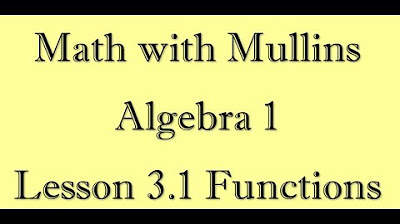Back to Algebra: What are Functions?
Summary
TLDRProfessor Dave's lesson introduces the concept of functions in algebra, explaining how they relate input and output values. Using the example of a 30% discount, he illustrates how a function operates and emphasizes the importance of the vertical line test for function graphs. The lesson also covers domain and range, zeroes of functions, and how to evaluate a function with a specific value, providing a foundational understanding of algebraic functions.
Takeaways
- 📚 The typical math curriculum involves teaching a year of algebra, followed by a year of geometry, and then another year of algebra, often called algebra two.
- 🔍 A function relates two quantities: an input value and an output value.
- 📦 You can think of a function as a box that, when given an input value, produces an output value based on the function's rule.
- 🛒 For example, if a store has a 30% off sale, the function to find the sale price would be F(x) = 0.7x, where x is the original price.
- 📈 Functions can be represented in tables and graphs, showing the relationship between input and output values.
- 🧪 A key property of functions is that each input value must produce exactly one output value, which is tested using the vertical line test on graphs.
- 💡 Multiple input values can produce the same output value in a function, but the reverse is not allowed.
- 📐 The domain of a function is the set of all possible input values, while the range is the set of all possible output values.
- 🧮 Identifying zeroes of a function involves finding the input values that make the function equal to zero, which are the x-intercepts on a graph.
- 📝 Evaluating a function involves substituting a given input value into the function's formula to calculate the corresponding output value.
Q & A
What is the standard sequence of math subjects taught in schools according to the transcript?
-The standard sequence is to teach a year of algebra first, followed by a year of geometry, and then another year of algebra, often referred to as algebra two.
What is the fundamental concept of a function in mathematics?
-A function is a mathematical concept that relates two quantities: an input value and an output value. It can be visualized as a box that takes an input and produces an output based on the function's definition.
How does the transcript illustrate the concept of a function with a real-world example?
-The transcript uses the example of a store offering a 30% discount on all items. The function to calculate the sale price is F(X) = 0.7X, where X is the original price and F(X) is the sale price.
What is the significance of the vertical line test in the context of functions?
-The vertical line test is used to determine if a graph represents a function. A graph passes the test if any vertical line drawn through it intersects the graph at only one point, indicating a single output for each input.
Why is there no horizontal line test mentioned in the transcript for functions?
-There is no horizontal line test because functions can have the same output for multiple inputs, meaning different X values can produce the same Y value.
What is the domain of a function?
-The domain of a function is the set of all possible input values that can be used in the function. For example, in the function F(X) = 2X + 1, the domain is all real numbers.
What is the range of a function, and how does it differ from the domain?
-The range of a function is the set of all possible output values that the function can produce. Unlike the domain, which often includes all real numbers, the range can vary significantly depending on the function and may not include all real numbers.
Why can't the value of X be zero in the function F(X) = 1/(X - 2)?
-In the function F(X) = 1/(X - 2), X cannot be zero because it would result in division by zero, which is undefined in mathematics.
What are the zeroes of a function, and how can they be identified graphically?
-The zeroes of a function are the input values that make the function equal to zero. Graphically, they can be identified as the X-intercepts where the graph of the function crosses the X-axis.
How is the function F(X) = 3X^2 - 5X + 2 evaluated for F(2) according to the transcript?
-To evaluate F(2), replace X with 2 in the function: F(2) = 3(2)^2 - 5(2) + 2. This simplifies to F(2) = 3(4) - 10 + 2, which equals 12 - 10 + 2, resulting in F(2) = 4.
Outlines

This section is available to paid users only. Please upgrade to access this part.
Upgrade NowMindmap

This section is available to paid users only. Please upgrade to access this part.
Upgrade NowKeywords

This section is available to paid users only. Please upgrade to access this part.
Upgrade NowHighlights

This section is available to paid users only. Please upgrade to access this part.
Upgrade NowTranscripts

This section is available to paid users only. Please upgrade to access this part.
Upgrade Now5.0 / 5 (0 votes)





